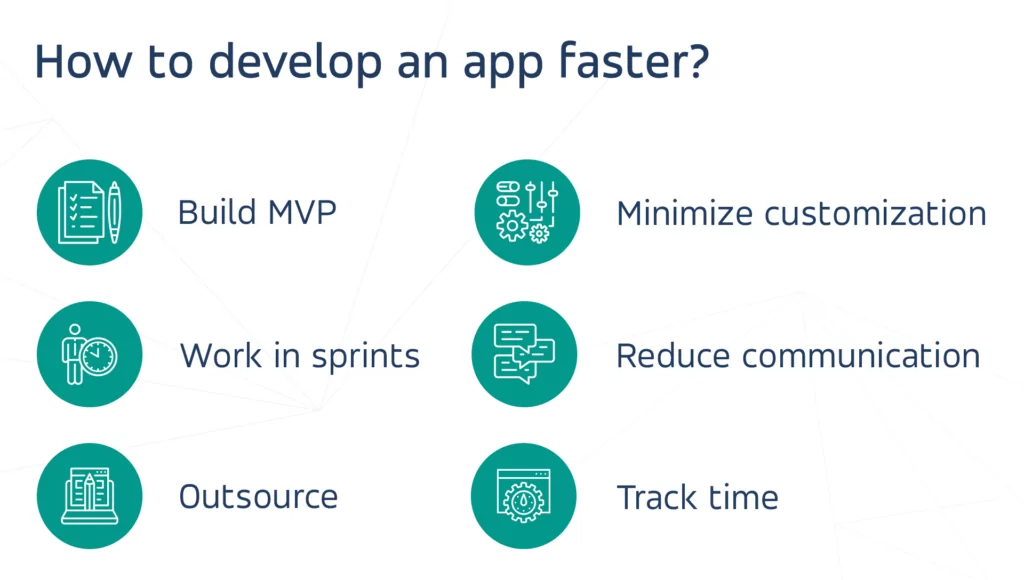We were surprised to discover how many people ask how long it takes to develop an application. What is more, we have even stumbled across online calculators that promised to count the time span at least roughly.
We’re afraid we’ll have to disappoint you because there is no way to estimate it precisely, automatically, and at the same time in a split second. App development depends on many factors, such as business goals and a current market situation. Working on an application involves risk analysis and agile response to changing conditions. But worry not; we won’t leave you empty-handed. Instead of telling you how long it takes, we will show you how to do it faster.
How to develop an application faster?
Below, we throw some light on six time-saving methods we find particularly useful in app development. They apply to different areas, including the very product, how it’s made, and how the team works.

Develop MVP first
You might have already heard this before, but building a minimum viable product first is a great way to kick off. Not only because it allows you to validate your idea but also because you can improve the working product early on. And “working” is the keyword here. We like to see an MVP as a kind of insurance, for one of its roles is to protect you against failure.
What can help you with building a minimum viable product, is defining and implementing the simplest process path, excluding the edge cases. Then, you can move on to the MoSCoW method, developing only the Must have features. We described this approach in detail in the article on effective planning in Scrum.
Minimize customization
It might be a truism to say that custom software development takes a lot of time. Well, unfortunately, that’s the state of affairs. Thankfully, we are familiar with strategies on how to minimize programming time, such as:
- Using ready-made components as often as possible, using custom development just to connect them
- Utilizing reusable components, so you develop them once and put them into action repeatedly in your app
- Ultimately, finding off-the-shelf software and applying slight modifications if possible.
Employing the above methods may involve changing the way we work to adjust to ready-made solutions. Still, sometimes it’s worth a try.

Minimize (inessential) communication
While open and efficient communication is essential for app development, it can also take the lion’s share of your people’s time. The following strategies will help you minimize time spent on communicating while maintaining productivity on a desired level:
- Create a communication plan.
To avoid meetings that could have been emails, create a set of communication channels and guidelines, and designate people responsible for communication. Use real-time communication tools like Slack, Mattermost, or Google Chat whenever questions arise. Instead of sending your messages to all team members, target particular groups of stakeholders.
- Be transparent.
Use project management tools that everyone can access, to keep track of the task progress and milestones, and avoid unnecessary questions. Keeping the team on the same page saves a lot of time. - Define tasks precisely.
While breaking the project into digestible bits, use a why-what-how approach. Make sure that everyone knows what to do and who’s responsible for task delivery to avoid misunderstandings. This way increases the probability you meet the estimated time for app creation. - Document your work.
Use software development documentation tools. This way, your developers, system administrators, testers, and other technical stakeholders will know where to find essential information on the app, not bothering others.
We’re aware it may seem tangled. But the good news is, we can help you structurize communication in web development projects. Have a look at our consultations, which are free of charge.
Work in sprints
Long-term goals are, by definition, hard to achieve, and the workload involved becomes challenging to estimate accurately. Such situations often lead to discrepancies between the initial calculations and final results. That’s why we recommend working in sprints, which produces predictable results and cyclical growth of functionalities. With the planned sprints list, the timeline for app development becomes more controllable and achievable.
Moreover, clear sprint goals affect productivity. Being aware of short deadlines, the team members are more energized to complete their tasks in time. Achieving smaller but frequent objectives is highly motivating as everyone likes to celebrate quick successes.

Outsource
Although it might be a favored option, having an in-house development team isn’t the fastest way to get things done. You need to recruit every single team member, introduce them to your processes, and make them understand each other to finally work as a well-oiled machine. Consider their holiday and sick leaves, which might hold off development even further.
Thus, outsourcing is a common way of kick-starting your project. You hire a whole dev team that is used to working as a team, and if someone is absent for a longer time, it is your contractor that is responsible for filling in.
If you already have an internal team that isn’t big, skilled, or effective enough, there’s a third way out: a mixed development team. It consists of both in-house and outsourced programmers who band together to achieve your business goals.
Track time
According to the Pareto principle, 80% of the app can be developed in 20% of the total estimated time. Also, we’ve heard on the grapevine ;), that some programmers like to polish details that are not that essential in terms of the app operation. Thus, it is crucial to focus on key endeavors, leaving out those that bring the lowest business value. Tracking time devoted to particular tasks will allow you to hunt down both groups of tasks and allocate your resources accordingly.
Moreover, keeping a tally of working hours will help avoid time-consuming micromanagement. After a few sprints with accurate time-tracking, you should finally know the answer to How many hours does it take to develop an app? quite precisely.
Wrap-up
Time is money; we have no doubts about that. So, instead of answering the tricky question: How long does it take to make an app? we choose to provide you with some handy tips on how to make it faster. We reckon they are altogether more valuable because you can apply them no matter what digital product you’re building.
At a close, we’re always here to give you a hand with development time estimates, so don’t think twice and contact us. Thanks for reading, and see you in the following write-up!





